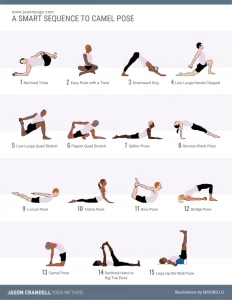If you sign up for Module I, when you login to our educational platform, Kartra, you will see this 👇 — a six-part downloadable manual to call your own.
Today I thought it would be fun to give you a share a tiny excerpt from the Module I Teacher Training Manual. It’s from Part 6: Communication — The Most Common Verbal Miscues. The manual itself is full color and engaging and it looks like this 👇
Here’s the excerpt:
Listen, we all teach LIVE, right? So, you’re going to make countless little mistakes. You’re going to forget sides, you’re going to screw up your flows, you’re going to get tongue-tied, and you’re going to say things that make absolutely no sense.
See How to Survive the Worst Yoga Class You’ve Ever Taught
Thankfully, our students don’t usually notice. However, there are some slightly more systemic misfires and mistakes we should all be aware of. Here are a few:
1. “ing inging” your students to death.
Uhh… what? “ing inging” your students to death is when you state every damn verb in your cues in the present tense. Here’s an example: “inhaling, reaching your arms overhead, exhaling, forward bending, inhaling, lifting half-way up, exhaling, forward bending, inhaling…” You get the idea.
2. Using excessive jargon.
This is when we use turns of phrase and vocabulary that don’t actually make sense out of context. Using excessive jargon requires students to be “in the know” and usually leaves many students out of the loop.
Anatomical language and Sanskrit can be considered jargon. So, be mindful that you try to explain things in a way that anyone can understand. Mula bandha is a great example. Can you actually teach someone mula bandha without using the phrase Mula Bandha? If not, don’t teach it.
3. Never arriving at a clear instruction.
It is OK to kindly and respectfully tell people exactly what you’d like them to do in class. You can give options, too. However, don’t feel like you have to beat around the bush or apologize for asking students to do specific things in class.
4. Using too many filler words.
Um, Okay. Like, yes. Uh-huh. Totally. Yep.
5. Making claims — especially medical ones.
Imagine that there is a professional medical fact-checker taking every single one of your classes.
6. Teaching a script instead of teaching from a true understanding.
We’re all going to parrot our teachers from time to time. We’re social creatures and our teacher’s tone and mannerisms will influence us. But, it’s important to let your teaching actually come from the experience of your own body.
7. Trying to teach everyone everything about every pose in every class.
No, you don’t need to do this. Pick a couple of focal points and stick to them. Repeat them. This is how people actually learn.
For more details and to join the waitlist for Module I: Creating Space and Freedom in the Hips + Legs, click here.






